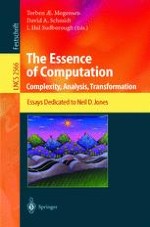By presenting state-of-the-art aspects of the theory of computation, this book commemorates the 60th birthday of Neil D. Jones, whose scientific career parallels the evolution of computation theory itself.
The 20 reviewed research papers presented together with a brief survey of the work of Neil D. Jones were written by scientists who have worked with him, in the roles of student, colleague, and, in one case, mentor. In accordance with the Festschrift's subtitle, the papers are organized in parts on computational complexity, program analysis, and program transformation.
